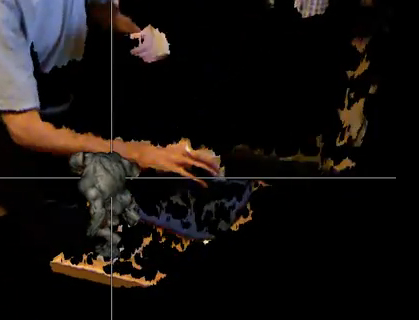I would have put ŌĆ£true 3DŌĆØ in quotes in the title, but thatŌĆÖs not actually possible with my blogging software, so take that with a grain of salt. What IŌĆÖm referencing is a great analysis of ŌĆ£true 3DŌĆØ vs. ŌĆ£pseudo-3DŌĆØ as put forth by Oliver Kreylos, a professor at the University of California-Davis, whoŌĆÖs interviewed in this MachineDesign.com article by Leslie Gordon on the use of Kinect in 3D modeling.┬Ā
┬Ā
Great piece. One of the best IŌĆÖve seen on Kinect and why itŌĆÖs so exciting for 3D imaging professionals and computer programmers in that it doesnŌĆÖt just try to wow with YouTube videos.
┬Ā
But IŌĆÖm most interested in the way that Kreylos talks about 3D and I think it might be useful for those of you who find yourselves talking about 3D with asset owners or even people at cocktail parties who might be new to commercial uses of 3D and just know 3D from watching Avatar with their kids.┬Ā
┬Ā
Kreylos calls what heŌĆÖs creating with Kinect a ŌĆ£3D holographic image,ŌĆØ even though itŌĆÖs not creating a hologram in any of the ways that we normally think of one. So, why ŌĆ£holographicŌĆØ?
┬Ā
HereŌĆÖs how he lays it out:
┬Ā
ŌĆ£The term ŌĆśholographicŌĆÖ is actually technically incorrect. But I felt I had to use it to distinguish the true 3D video coming from the Kinect from pseudo-3D stereoscopic video such as whatŌĆÖs shown in ŌĆś3DŌĆÖ movies such as Avatar, or captured by available ŌĆś3D cameras.ŌĆÖ The difference is that pseudo-3D video can only be viewed from the point-of-view of the camera that originally recorded it, just like regular 2D video. True 3D video, on the other hand, can be viewed from any arbitrary viewpoint, even after it has been captured. It has this property in common with real holograms, hence I chose the moniker as a short-hand.ŌĆØ┬Ā
┬Ā
Kreylos explains that, colloquially speaking, Jim Cameron could not go into the editing room after shooting a live-action scene in Avatar, and say, ŌĆ£OK thatŌĆÖs great, now letŌĆÖs see this scene from the point-of-view of that blue guy on the right,ŌĆØ says Kreylos. ŌĆ£Although this is possible with true 3D video, a true 3D video camera is still a camera and it cannot see through or around solid objects. This means users would need multiple Kinects to pull off the full effect. For example, because a 3D camera can only create a 3D model of what it sees, a 3D holographic model of me would only shows one side of my body. We call this half-representation a ŌĆśfacade.ŌĆÖ Using multiple cameras would allow combining respective facades into complete 3D objects, an ongoing area of my research.ŌĆØ┬Ā
┬Ā
First, I love that Leslie Gordon refers to ŌĆ£Jim CameronŌĆØ like theyŌĆÖre buddies. You know, Jim, the guy who made Avatar. ThatŌĆÖs terrific.┬Ā
┬Ā
But, more importantly, this guy Kreylos is essentially talking about registering point clouds, and itŌĆÖs where surveyors can come in and talk about the importance of the work they do, integrating GPS, etc., to make sure that the point clouds they create have real-world references that make them valuable. This coming together of the worlds of computer programming and 3D modeling and getting excited about the possibilities of 3D imaging with the precise world of surveying and engineering is where things could get really cool and useful at the same time.┬Ā
┬Ā
Anyway, at least when someone says at a party, ŌĆ£oh, I LOVED Avatar,ŌĆØ after youŌĆÖve told them you work in 3D, at least you have another crib sheet for explaining to them what it is youŌĆÖre really after.






